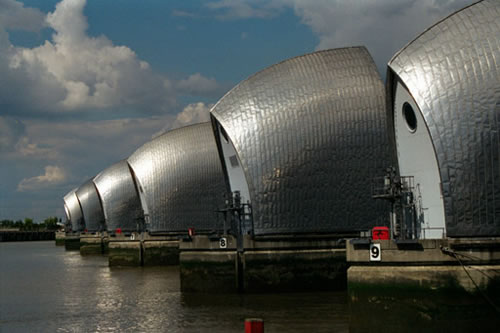Real Towns wear Dikes

What I really enjoy studying is engineering disasters. When something goes wrong – you have a chance to see what can be done or what mistake was made. You all know about the Katrina disaster in New Orleans. Well it was an irony – that USA had the technology to predict and warn the people – but didn’t have the common sense to evacuate or reinforce.


That’s the city after the flooding – here are the dikes that were used.

These – as you can see are really no brainers and failed easily. About 2000 people died and its really the people that built these dikes – saving the dollars - that could have done something else. They are ment to be walls that prevent the water from entering the town. It clearly did not do the job.
Rotterdam
In 1953 – there was a huge flood in Rotterdam, Netherlands that seriously damaged the place - killed around 2000 people. (Fifty years and USA system behaved like the 1953s).
Now, Rotterdam is below sea level – which means it’s prone to such disasters. So, that had a project to build an engineering structure to prevent flooding. This flood prevention system known as Delta Works Project was constructed. Out of all the engineering wonders that you can come across around the world, this I think – is the definition of wonder. It was built to prevent natural disasters – that is, prevent the nature from destroying civilization and works magnificently.
Here is a satellite map of the Rotterdam area that I got on Google maps. You may use the link to check more details. The yellow map shows the conceptual location of eeach of the dikes – there are about 13 of them.


Oosterscheldekering (Don’t try to pronounce it – in English its The Eastern Schelde)

The nine kilometer-long Oosterscheldekering (kering meaning barrier) was initially designed, and partly built, as a closed dam, but after public protest huge sluice-gate-type doors were installed in the remaining four kilometers. These doors are normally open, but can be closed under adverse weather conditions. In this way the saltwater marine life behind the dam is preserved and fishing can continue, while the land behind the dam is safe from the water.

This shows the structure at work.
Unfortunately – I can’t get much pictures of it.

Maeslantkering

The construction of the Maeslantkering was a part of the "Europoortkering"-project which, in turn, was the final stage of the Delta Works. The main objective of this Europoortkering-project was improving the safety against flooding of the Rotterdam harbour, of which the Europoort is an important part, and the surrounding towns and agricultural areas

Stormsurgebarrier

Hartel Barrier

Well these are all the pictures I have. If I do get more, I will make another blog about it. This network of dams and dikes is really a wonder and something to learn from. Infact, not only New Orleans - many Asian projects have considered this flood prevention system. This is of course for Tsunami defense in the Asian costal areas. So I am sure that we will be seeing more of these dams springing up around the world.
P.S : Picture at the very top is a Levee system used in UK. Its not a part of the Delta Works project - but the 1953 flood also affected UK and these systems play an important role.
Credits :
http://www.deltawerken.com/Deltaworks/23.html
http://en.wikipedia.org/wiki/Delta_Works
http://en.wikipedia.org/wiki/Oosterscheldekering
http://www.commondreams.org/headlines06/0112-15.htm
